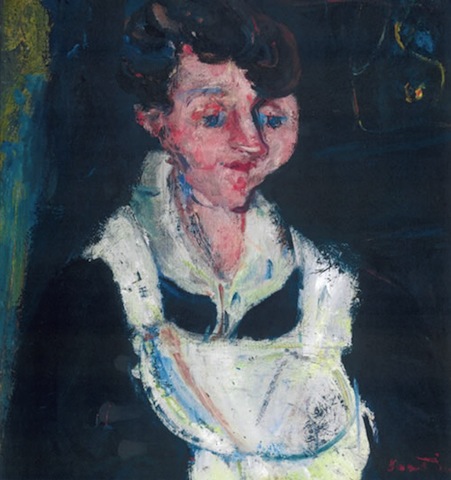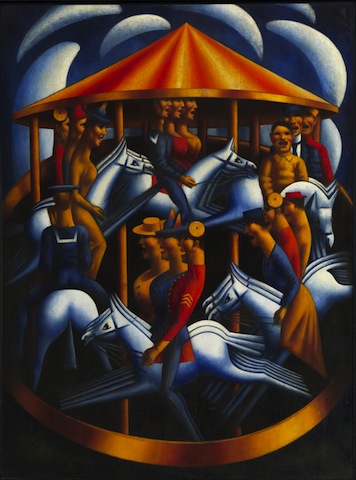The exhibition Out of Chaos is a powerful dose of specific human experience, here presented almost exclusively in the form of portraits and group scenes. The selection comes almost entirely from the more than 1,300 works of art owned by Ben Uri Gallery, whose centenary commemoration this is; the gallery was founded in 1915, primarily to explore the work of Jewish artists in Britain. The majority of those in the collection are immigrants or first generation, with a few from beyond this island to expand on the Jewish experience.
Several score works are arranged in chronological clusters, in six galleries, around themes which attempt to encompass in pertinent phrases complex journeys: integration, identity, conflict, forced journeys, and journeys of choice. The last may be exemplified by the American RB Kitaj, one of the most self-consciously Jewish of artists; he studied at the Royal College, and became the first American RA after John Singer Sargent. Here is Kitaj’s pastel portrait drawing of Sir Claus Moser, his subject’s expression thoughtful and fixed on something beyond the viewer. Moser perhaps too is a symbol of the quite astonishing contribution Jewish émigrés have made to Britain: the son of a banker, he came to Britain with his family as a teenager in 1936. A gifted pianist, he was to become the government’s chief statistician, chairman of the Royal Opera House, a peer, and head of an Oxford college; and yet perhaps in some ways he remained an outsider.
The art, ranging from the late 19th century to our own times, raises a host of questions clustered about notions primarily of identity, adjustment and assimilation, and the necessities of migration: economic, political, for survival. In ways that could not necessarily have been foreseent it is remarkably relevant now, when questions of immigration, forced or otherwise, are of crucial importance and reach beyond individual stories to society as a whole. It is also about the adjustment of small communities, which may experience discrimination or worse. This is an exhibition that makes one look – hard – and perhaps think even harder. But the well organised display can simply be enjoyed as a spectrum of vivid and memorable work. The biographies are enriching, though.
 Chaim Soutine, a Russian Jew, emigrated to Paris, becoming part of the École de Paris, which was primarily made up of emigrant Jews. His La Soubrette, c.1933 (pictured left), is a brilliantly compelling portrait of a maid in uniform, her weary face expressive of a fatigue beyond the efforts of the day.
Chaim Soutine, a Russian Jew, emigrated to Paris, becoming part of the École de Paris, which was primarily made up of emigrant Jews. His La Soubrette, c.1933 (pictured left), is a brilliantly compelling portrait of a maid in uniform, her weary face expressive of a fatigue beyond the efforts of the day.
Frank Auerbach, represented here with a charcoal art school drawing of a nude, and a mesmerising small cityscape of Mornington Crescent, came to London from Berlin as a child of eight in 1939; his parents died in a concentration camp in the 1940s.
Georg Grosz was in fact from a Lutheran family, and so is much more of an example of someone forced out by the Nazi ideological rage at the avant garde, and therefore in this context slightly more problematical except for his subject matter, a savage critique of his prejudiced and corrupt society. His searingly powerful drawing, The Lecture (Letter to an Anti-Semite) from 1935, is one of several he did of his close friend, the radical Jewish writer Erich Mühsam, who was killed in 1934 in a concentration camp. A thug is pointing to a drawing within the drawing, portraying the victim – and the Talmud. Already in self-exile in New York, Grosz in another drawing depicts Mühsam being beaten in The Interrogation, 1938 (main picture).
Among the distinctive artists who fled 1930s Germany were Ludwig Meidner, devoutly religious, here represented by a powerful drawing, Portrait of a Girl, 1922, and Jankel Adler, with his etching Ein Jude – just that, a bearded man, hand to head, thinking on something far beyond our ken. The Pole, Josef Herman, who fled from Warsaw to Belgium, and then through France and England to Glasgow in 1940, depicts a family of terrified Refugees, c.1941, in colours resonant of nightmare; in the moonlit city, a huge cat, holding a rat in its mouth, stalks the rooftops above.
Does the 'chaos' in the title refer to the difficult lives the migrants left behind them?
It is unusual to have an exhibition where the individual biography is perhaps as important a reason for inclusion as the art itself. It is not only that every picture tells a story, but that there is a complex story for every artist. One of the most powerful images on view is a late self-portrait, from 1927 when the artist was already in his eighties, by the German establishment figure Max Liebermann, a leading German impressionist, an assimilated Jew whose honours were stripped from him in the 1930s. It is oddly prescient: wise, sorrowful, subtly knowing.
From an earlier period, The Emigrants, c.1910, by the Belgian artist Victor Hageman, an empathetic social realist, portrays an extraordinary group of three generations of a Russian Jewish family, poignant, wistful, possibly on their way to America; the painting belonged to the owners of Antwerp’s Red Star Line, whose ships took thousands from Europe across the Atlantic.
There are scenes specific to Judaism: the cloaked figures of the Russian-born Jacob Kramer’s Day of Atonement, 1919, a frieze of bearded male figures, robed and processing on one of the holiest of Jewish religious holidays. An exceptionally powerful double portrait drawing by Mark Gertler (a Galician Jew born in Spitalfields), Rabbi and Rabbitzin, 1914, shows a wide-eyed couple, monumental and impassive yet somehow highly emotional, portrayed in a stylised but humble setting, marrying still-life and abstraction.
 One of the most striking paintings suggesting the horrors of World War One is Gertler’s Merry-Go-Round, 1916 (pictured above), a brilliantly lurid merry-go-round with its passengers, some in military uniform, robotic, mouths open in silent screams. It is an endless circle and no one can dismount or escape, doomed in perpetuity. This exceptionally memorable image, in a spectrum of colours – harshly fluorescent oranges and yellows, deep reds and blues – of men and women trapped forever in a ghastly cycle, endlessly circling, still stuns. DH Lawrence called it “horrible and terrifying”. Once owned by the Ben Uri, it was sold to the Tate in 1984 to provide funds to support the continued acquisition programme.
One of the most striking paintings suggesting the horrors of World War One is Gertler’s Merry-Go-Round, 1916 (pictured above), a brilliantly lurid merry-go-round with its passengers, some in military uniform, robotic, mouths open in silent screams. It is an endless circle and no one can dismount or escape, doomed in perpetuity. This exceptionally memorable image, in a spectrum of colours – harshly fluorescent oranges and yellows, deep reds and blues – of men and women trapped forever in a ghastly cycle, endlessly circling, still stuns. DH Lawrence called it “horrible and terrifying”. Once owned by the Ben Uri, it was sold to the Tate in 1984 to provide funds to support the continued acquisition programme.
For the show as a whole "Out of Chaos" is an intriguingly ambiguous title; does the chaos refer to the difficult lives the migrants, or their families, left behind them – Eastern European poverty, the casual and sometimes deadly prejudice in England itself, the hideous prelude of persecution and death in the 1930s before the Second World War? Or does it mean the attempts to make of imagination and skill something more than the chaos of – well – a life of effort and struggle.
The exhibition itself is a signal for a hoped-for expansion, and a move for the Ben Uri Gallery from North to Central London in the near future. Based on its collection and massive outreach and education programmes, the Ben Uri is attempting to redefine itself not just as an art collection but an organisation concerned to deliberately look at notions of identity for a variety of migrant groups beyond specific Jewish émigré experience – and what a migrant background might mean for the making of art, encapsulated in their phrase “art, identity, migration”. This is an enormous subject, as complex as the various ethnic identities that make up London today. While laudable in attempting to reach beyond the immensely varied experiences of one community – complicated enough – this may well be a step too far. In seeking a wider relevance, the strength of what the Ben Uri currently stands for risks being seriously weakened.









![SEX MONEY RACE RELIGION [2016] by Gilbert and George. Installation shot of Gilbert & George 21ST CENTURY PICTURES Hayward Gallery](/sites/default/files/styles/thumbnail_125_x_125_/public/mastimages/Gilbert%20%26%20George_%2021ST%20CENTURY%20PICTURES.%20SEX%20MONEY%20RACE%20RELIGION%20%5B2016%5D.%20Photo_%20Mark%20Blower.%20Courtesy%20of%20the%20Gilbert%20%26%20George%20and%20the%20Hayward%20Gallery._0.jpg?itok=3oW-Y84i)





Add comment